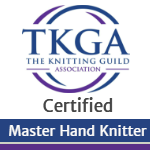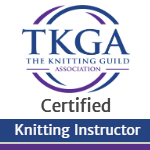Last week I talked about how to identify certain tension issues. This week I’m going to focus on gutters specifically.
Here is a video on gutters – some ideas on how to identify, and how to remedy the issue:
Here are some more thoughts:
Another method to try to identify whether it is the knits or the purls:
- Use the two colors, but carry the yarns up the side of the swatch. Do not bind off. Cut the strands in between every other row so that you have single strands for each row (and they are each cut at each end.) Remove your needle and unravel the swatch. The strands that are longer are the stitches that take up more yarn. (Make sure you know which color you knit with and which you purled with!) This is a good method if it is a very subtle difference – you should see a length difference even if it is a slight one. You can do this with a single color as well, you just have to come up with a way to indicate which strands are your knit strands and which are your purls. You could use a marker to mark all the purl stitches, or use some other method to mark either all the purls or all the knits.
Since gutters are the result of *all* of the stitches of one kind being larger, my best advice is simply to practice making those stitches tighter (with tighter yarn tension around the hand, or just simply working them tighter) – and get to where it is habit to make them the appropriate size. I know, no one likes to hear “practice, practice, practice!” But, sometimes it’s the only real answer.
Don’t rely on “cheat” methods of covering up the problem, because then it’s just going to rear its ugly head in other situations and frustrate you. A “cheat” method is using different size needles, or using just the tips of the needles. Using different sized needles won’t work consistently as I say in the video. Using just the tips of the needles isn’t ideal either – because needle tips are varying sizes, and we use needle sizes for reason– as our “measuring cup” to size our stitches. Using the tips of the needles to form a stitch is like throwing away the measuring cup and just winging a recipe. Sometimes you can get away with it, but other times you cannot.
I hope some of these ideas are helpful in moving you to more consistent and even knitting!
Next week, we’ll look at rowing out specifically. Until then, Happy Knitting!




